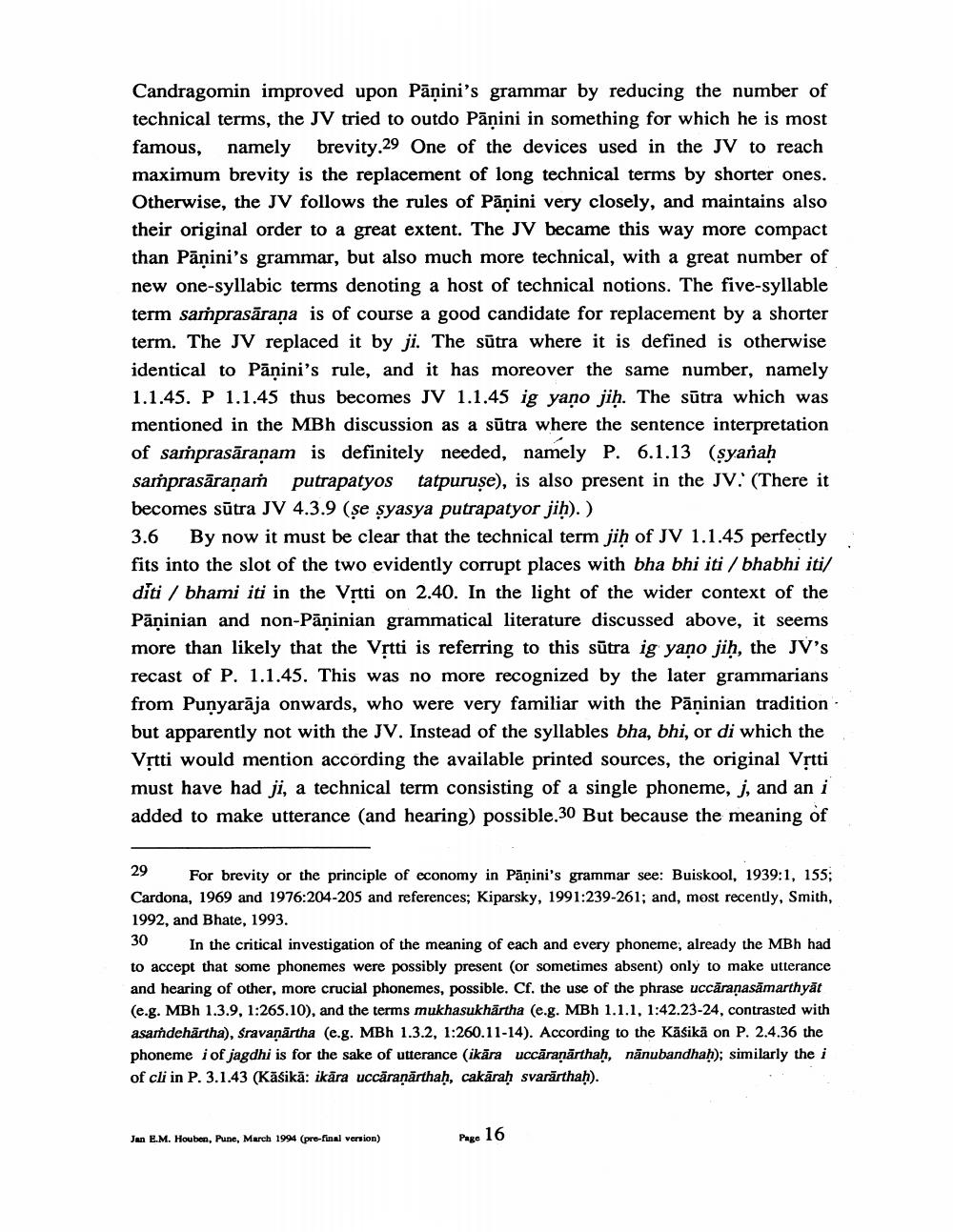________________
Candragomin improved upon Panini's grammar by reducing the number of technical terms, the JV tried to outdo Panini in something for which he is most famous, namely brevity,29 One of the devices used in the JV to reach maximum brevity is the replacement of long technical terms by shorter ones. Otherwise, the JV follows the rules of Panini very closely, and maintains also their original order to a great extent. The JV became this way more compact than Panini's grammar, but also much more technical, with a great number of new one-syllabic terms denoting a host of technical notions. The five-syllable term saṁprasāraṇa is of course a good candidate for replacement by a shorter term. The JV replaced it by ji. The sütra where it is defined is otherwise identical to Panini's rule, and it has moreover the same number, namely 1.1.45. P 1.1.45 thus becomes JV 1.1.45 ig yano jih. The sūtra which was mentioned in the MBh discussion as a sūtra where the sentence interpretation of samprasaraṇam is definitely needed, namely P. 6.1.13 (syañaḥ samprasāraṇaṁ sariprasaranamh putrapatyos tatpuruşe), is also present in the JV. (There it becomes sütra JV 4.3.9 (se syasya putrapatyor jiḥ).)
3.6 By now it must be clear that the technical term jiḥ of JV 1.1.45 perfectly fits into the slot of the two evidently corrupt places with bha bhi iti /bhabhi iti/ diti / bhami iti in the Vṛtti on 2.40. In the light of the wider context of the Paninian and non-Paninian grammatical literature discussed above, it seems more than likely that the Vṛtti is referring to this sūtra ig yano jih, the JV's recast of P. 1.1.45. This was no more recognized by the later grammarians from Punyarāja onwards, who were very familiar with the Päṇinian tradition but apparently not with the JV. Instead of the syllables bha, bhi, or di which the Vṛtti would mention according the available printed sources, the original Vṛtti must have had ji, a technical term consisting of a single phoneme, j, and an i added to make utterance (and hearing) possible.30 But because the meaning of
29
For brevity or the principle of economy in Panini's grammar see: Buiskool, 1939:1, 155; Cardona, 1969 and 1976:204-205 and references; Kiparsky, 1991:239-261; and, most recently, Smith, 1992, and Bhate, 1993.
30
In the critical investigation of the meaning of each and every phoneme, already the MBh had to accept that some phonemes were possibly present (or sometimes absent) only to make utterance and hearing of other, more crucial phonemes, possible. Cf. the use of the phrase uccaraṇasāmarthyāt (e.g. MBH 1.3.9, 1:265.10), and the terms mukhasukhārtha (e.g. MBh 1.1.1, 1:42.23-24, contrasted with asaṁdehārtha), śravaṇārtha (e.g. MBh 1.3.2, 1:260.11-14). According to the Käsikä on P. 2.4.36 the phoneme i of jagdhi is for the sake of utterance (ikära uccaraṇārthaḥ, nanubandhaḥ); similarly the i of cli in P. 3.1.43 (Kāšikā: ikāra uccaraṇārthaḥ, cakāraḥ svararthaḥ).
Jan E.M. Houben, Pune, March 1994 (pre-final version)
Page
16




